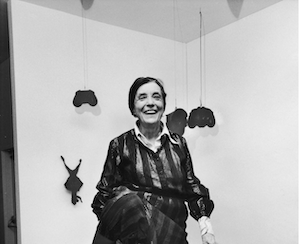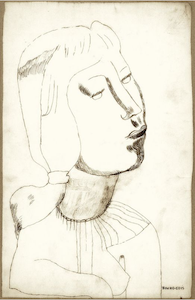
Louise Bourgeois was a French-American artist who contributed to many aspects of artistry during the 20th century. Bourgeois was born on December 25th, 1911 in Paris, France. Living with her family, she grew up learning about art from her parents, Joséphine Fauriaux and Louis Bourgeois. Both were weavers and created several tapestry designs. At times, she would provide insight to her parents’ and her two older siblings’ art, by sketching drawings to commemorate tapestries from ancient time periods. At the outbreak of World War I, Bourgeois’s father played a vital role in serving his country. His absence had a large impact on the family and Bourgeois’s mother began to fear that her husband would not return. However, as the war came to a halt, her father returned home safely and they moved to a small town in Paris, Choisy-le-Roi. The family started a tapestry business and Bourgeois played a crucial part in designing pieces, filling in missing tapestry gaps to complete their ancient patterns.
In 1919, Bourgeois attended grade school in the School Public Fénelon in Paris, France. Between 1930 and 1932, Bourgeois began her education by engaging in two concepts that interested her, math and geometry. As her love for architecture and designing began to develop, she shifted her interest to the arts. Throughout 1935 to 1938, she attended multiple art colleges, including the École du Louvre and the Ecole Municipale de Dessin et d'Art. Studying the topics in which she was most interested, she was able to receive a college bachelor’s degree in philosophy. As soon as she completed art school, she studied with professor Fernand Léger at the École des Beaux-Arts, who taught her the fundamentals of architecture.

In 1938, Bourgeois decided to mirror her parents and start her own tapestry shop in a location coincidentally near their business. At her shop, she met historian Robert Goldwater, who shared similar interests with her, such as arts and architecture. The two eventually got married, and traveled to New York, where Bourgeois was able to expand her career. By visiting several museums and learning more about the city’s art, she was able to unveil new opportunities for herself. The artistic characteristics of New York inspired and challenged her. The dynamics of the environment encouraged her to think outside of the box and to create sculptures that represented unique creations. Today, her work can be seen in the Metropolitan Museum of Art where she has an exhibition dedicated to her art work.
Throughout her career, she achieved numerous accolades based on her art pieces. A few of her works include Cells Series and the Destruction of the Father. Two of her most notable awards include the Life Time Achievement in Contemporary Sculpture in 1991 in Washington D.C., and the National Medal of Arts in 1997. While meeting with new people, she was able to have her artwork featured in the National Museum of Modern Art (MoMa). With her hard work and dedication, she reached out to publishers and showcased her artwork to make her exhibition possible. By publishing her artwork, her accomplishments have inspired many feminist changemakers during her time such as Lynda Benglis.

One of her pieces entitled Maman Spider features a shape of a spider that stands up high. The structure itself serves as a meaningful purpose to Bourgeois’ early life; she often faced difficult times as a child, and decided to implement the spider structure to further elaborate on her idea of togetherness and safety. She dealt with difficult challenges when she was younger and by sculpting the spider figure, she gained protection. The formation of the spider was constructed with both marble and steel to stand tall, allowing the spectators to walk under the sculpture.
Through this composition, Bourgeois expresses her inner self and identity by illustrating her sense of kindness to the people who surround her. Her work not only captivates viewers to understand her mindset when constructing the piece, but also her perspective on life.
Louise Bourgeois had three children, Jean-Louis Bourgeois, Michel Goldwater, Alain Goldwater. She died on May 31, 2010, in New York at ninety-eight years old. Through her collection in the MoMa, many have been able to learn more about her life through the preserved An Unfolding Portrait exhibition. As she continues to inspire many women today, Bourgeois’s legacy continues and serves her mission of evoking emotions through her artwork. Inspired by the sentimental touch she used in her paintings, many female trailblazers have become passionate about her work. Overall, Louise Bourgeois has had a profound impact on society and has been a source of inspiration for many future aspiring artists.
Why Did I Choose to Research Louise Bourgeois?
Walking down the paths in my community, I have noticed many pieces of artwork like flyers, posters, boards, and murals. Frequently seeing large paintings on the side of buildings, I have always wanted to learn more about artists and their motivations. Through my research on Louise Bourgeois’s career and education, I got a glimpse into the background of an artist who has garnered outstanding accomplishments. Furthermore, I chose to research Louise Bourgeois as I enjoyed viewing her sculptures and drawings, which have greatly contributed to the feminist art movement. Although I do not have any personal connections to Bourgeois, she inspires me to educate myself more on both artwork and architecture. By learning from Bourgeois’s mission, I have been able to teach myself about the world of the arts, a revelation that has been truly inspiring.
Works Cited
Eschmann, M. (2020, April 12). 6 Iconic Female Artists You Should Know. TheCollector. Retrieved August 18, 2022, from https://www.thecollector.com/female-artists/.
Gersh, B. (2019, March 11). Biography of Artist Louise Bourgeois. ThoughtCo. Retrieved August 18, 2022, from https://www.thoughtco.com/louise-bourgeois-quick-facts-183337.
Louise Bourgeois. (n.d.). MoMA. Retrieved August 18, 2022, from https://www.moma.org/artists/710.
Louise Bourgeois | French-born American sculptor | Britannica. (n.d.). Encyclopedia Britannica. Retrieved August 18, 2022, from https://www.britannica.com/biography/Louise-Bourgeois.
Louise Bourgeois' spider Maman - Everything you need to know. (n.d.). Public Delivery. Retrieved December 9, 2022, from https://publicdelivery.org/louise-bourgeois-spider-maman/#Themes_of_her_work.
This article was published on 2/16/23